
Fact sheet
79215 is a holocrystalline, feldspar-rich rock with a granoblastic texture that was formed by a high temperature metamorphic process of unknown origin. It is apparently an annealed aggregate of relict anorthositic and troctolitic cumulates, with an added meteoritic component. Equant plagioclase grains meet at 120 degree triple junctions with smaller intersertal grains of olivine, pyroxene and opaque minerals. Within 79215 are numerous “oxide complexes” with surrounding reaction corona. These complexes consist of core assemblages which may include spinel, ilmenite, armalcolite, troilite, rutile and metallic iron which are surrounded by a corona of plagioclase and occasionally olivine. Chromite spinel is the dominant constituent of the oxide assemblages.
The sample weighed 553.8 grams before analysis and has been dated at 4.03±0.02 billion years old (Ar/Ar).
Further details of this and other Apollo samples are here: http://curator.jsc.nasa.gov/
Apollo 17, the final manned landing mission, had two objectives: to obtain samples of ancient rocks from the lunar highlands and to look for evidence of younger volcanic activity on the valley floor.
This small Collection contains material deriving from both periods, including igneous rocks around 4.3 billion years old from the lunar highlands as well as younger volcanic samples dating from about 3.6 billion years ago.
Apollo 17 was launched on 7 December 1972.






